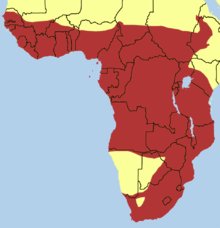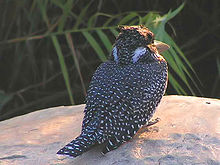- Giant Kingfisher
-
Giant Kingfisher 
Male at Abuko, The Gambia Conservation status Scientific classification Kingdom: Animalia Phylum: Chordata Class: Aves Order: Coraciiformes Family: Cerylidae Genus: Megaceryle Species: M. maxima Binomial name Megaceryle maxima
(Pallas, 1769)
The Distribution of the Giant Kingfisher The Giant Kingfisher (Megaceryle maxima) is the largest kingfisher in Africa, where it is a resident breeding bird over most of the continent south of the Sahara Desert other than the arid southwest.
There are two subspecies, M. m. maxima, found in open country, and M. m. gigantea in the rainforest. The forest race is darker, less spotted above, and more barred below than maxima, but the two forms intergrade along the forest edge zone.
Breeding is from August to January, 3–5 eggs being laid in a riverbank tunnel.
Giant Kingfisher is 42–48 cm long, with a large crest and finely spotted white on black upperparts. The male has a chestnut breast band and otherwise white underparts with dark flank barring, and the female has a white-spotted black breast band and chestnut belly.
The call is a loud wak wak wak.
This large species feeds on crabs, fish, and frogs, caught in the typical kingfisher way by a dive from a perch.
References
- BirdLife International (2004). Megaceryle maxima. 2006. IUCN Red List of Threatened Species. IUCN 2006. www.iucnredlist.org. Retrieved on 11 May 2006. Database entry includes justification for why this species is of least concern.
- C H Fry & Kathie Fry; illustrated by Alan Harris (2000). Kingfishers, Bee-eaters and Rollers. Princeton University Press. ISBN 0691048797.
Categories:- IUCN Red List least concern species
- Megaceryle
- Animals described in 1769
- Birds of Africa
Wikimedia Foundation. 2010.


